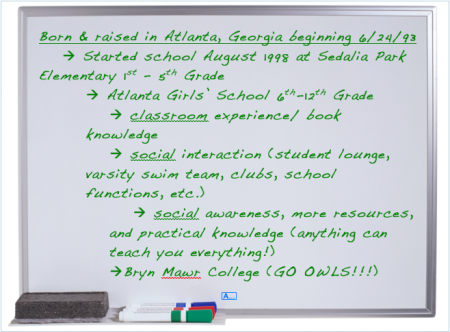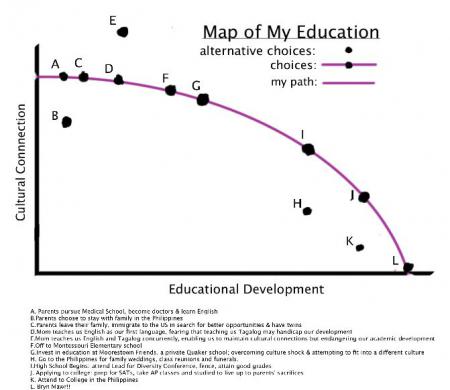Serendip is an independent site partnering with faculty at multiple colleges and universities around the world. Happy exploring!
Blogs

The Break Down of my Access Map
Home:
Born July 20, 1993. I grew up in a two parent household as an only child. My parents were very involved in my early education, reading to me and playing board games with me. My parents held positions on the PTA at my elementary and middle school. Between home and school there was an open dialect between my parents and teachers until high school.
School:
Complicated identities
Last week in class we discussed the article "Living the Good Lie" about homosexual men living outwardly as straight men, with wives and children. One of the driving forces behind their decisions to do this was that while they recognized their inward identity as being gay, their greater identity emphasis was on being religious. These men were willing to compromise their homosexual identity in favor of their (stronger) religious identity.

The Disabled Body as Sexualized
Eli Clare’s discussion of the Ellen Stohl magazine spread for playboy and her cover-shoot for New Mobility: a disability community magazine touches on many important questions surrounding disability and sexuality. Clare introduces this subject within part ii: bodies, “reading across the grain.” In this section he critically evaluates a few visual representations of disabled individuals and related advertisements.
Clare acknowledges the importance of the Stohl images as groundbreaking in their representation of a disabled body as a sexual being. Stolh echoes this goal in an interview she conducted with CBS in June 2011, nearly 25 years after the playboy spread debuted (http://losangeles.cbslocal.com/2011/06/21/disabled-woman-looks-back-at-posing-nude-for-playboy-challenging-stigmas/). In the interview she relates that in her proposal letter to Hugh Heffner she explained that “sexuality is the hardest thing for a disabled person to hold on to.”
Clare argues that although good intentioned, the playboy spread and the cover-shoot for the disability magazine are more problematic than beneficial. Clare problematizes some of the essential characteristics of the representations including Stohl’s conformation with the industry standards of beauty, and the choice of photos and text.

Rethinking Homogeny
Here is the link to the story about baby Storm, who is being raised gender-less. Sorry it took me a week to post.
http://abcnews.go.com/Health/baby-storm-raised-genderless-gender-dangerous-experiment-child/story?id=13693760
----------------------------------------------------------------------------
The articles and books that we have read thus far, and will continue to read, in this course have not just been interesting to me, but experience and thought-changers for me as well. I come from a very homogenous community - white, upper-middle class, mostly Jewish, suburban town. Our next biggest subgroups of people are Asians and Indians. Gay people are rarities - maybe one per grade (at least one "out of the closet" per grade). Transsexuals and transgenders do not exist. Those with disabilities are taken out of mainstream schools early on or never mainstreamed at all.

Week 2: Clare and Multiple Perspectives
For one of the first times in my college experience (kind of surprisingly, I guess) I am re-reading a text I encountered in a previous course. Eli Clare's Exile and Pride was also on the syllabus for an English class I took with Theresa Tensuan as a sophomore (hardly a coincidence, as her work on these topics is part of the other online reading for Tuesday). Since initially reading the book (largely for the way it adapts the autobiographical form in creative ways) my perspectives have certainly changed. Again, the metaphor of approaching the same questions from multiple angles, key to the interdisciplinary nature of our work in PPPP, maps well onto this revisiting of a text with different (gender-oriented) set of questions. However, the fundamental, unavoidable complicatedness Clare tries to convey -- especially the interrelatedness of social justice movements -- hit me with a memorable force both two years ago and this time around. We can get caught up in the specifics/feasibility of some of his recommendations, but I think he makes a pretty good case that the underlying forces of oppression cannot be parsed out into neatly divided identity categories, and that creative collaboration strategies -- whether his or our own -- are therefore necessary to social justice movements that wish to have more than shallow successes.







